-
 Bitcoin
Bitcoin $106,437.2012
0.82% -
 Ethereum
Ethereum $2,442.5287
0.82% -
 Tether USDt
Tether USDt $1.0005
-0.02% -
 XRP
XRP $2.1812
-0.27% -
 BNB
BNB $645.1327
0.45% -
 Solana
Solana $146.2379
0.39% -
 USDC
USDC $0.9999
-0.01% -
 TRON
TRON $0.2751
0.92% -
 Dogecoin
Dogecoin $0.1662
-0.23% -
 Cardano
Cardano $0.5827
-1.22% -
 Hyperliquid
Hyperliquid $37.5225
0.04% -
 Bitcoin Cash
Bitcoin Cash $479.0877
4.02% -
 Sui
Sui $2.7846
-3.27% -
 Chainlink
Chainlink $13.3576
0.84% -
 UNUS SED LEO
UNUS SED LEO $9.0252
-1.20% -
 Stellar
Stellar $0.2455
-1.07% -
 Avalanche
Avalanche $18.0680
-1.81% -
 Toncoin
Toncoin $2.8948
-1.07% -
 Shiba Inu
Shiba Inu $0.0...01164
-1.65% -
 Litecoin
Litecoin $85.0637
-0.06% -
 Hedera
Hedera $0.1526
-0.89% -
 Monero
Monero $316.2941
0.78% -
 Ethena USDe
Ethena USDe $1.0003
-0.04% -
 Polkadot
Polkadot $3.4113
-1.87% -
 Dai
Dai $1.0000
-0.01% -
 Bitget Token
Bitget Token $4.4488
5.16% -
 Uniswap
Uniswap $7.1740
3.09% -
 Pi
Pi $0.5968
11.43% -
 Pepe
Pepe $0.0...01010
-0.65% -
 Aave
Aave $264.3189
0.40%
Does the VR indicator break through 450 mean overheating?
The VR indicator, or Volume Ratio, helps crypto traders gauge buying and selling pressure by comparing up-day and down-day volumes, with readings above 450 signaling strong bullish momentum.
Jun 25, 2025 at 10:15 am
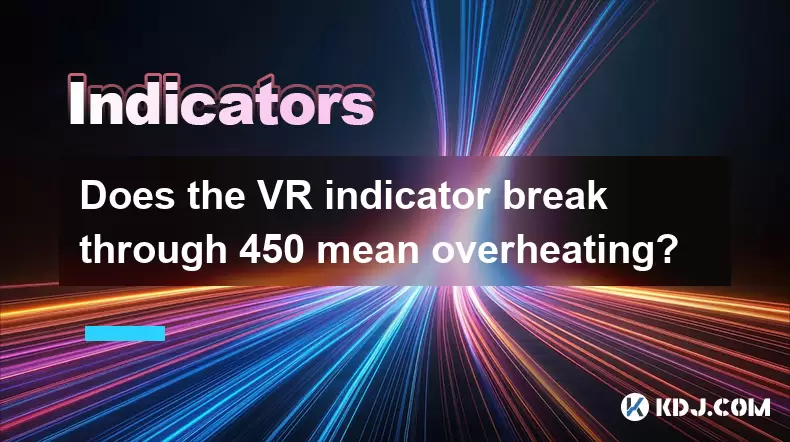
Understanding the VR Indicator in Cryptocurrency Analysis
The VR indicator, or Volume Ratio, is a technical analysis tool used to assess buying and selling pressure by comparing the volume of up days to down days over a specified period. In cryptocurrency trading, where volatility is high and sentiment shifts rapidly, the VR indicator helps traders identify potential trend reversals or confirm existing trends.
In the context of cryptocurrencies like Bitcoin, Ethereum, or altcoins, the VR indicator is particularly useful due to the market’s sensitivity to volume changes. When the VR line crosses key thresholds, such as 450, it may signal an important shift in momentum that traders need to interpret carefully.
Important Note: The interpretation of the VR indicator should always be done in conjunction with other tools like moving averages, RSI, or MACD to avoid false signals.
What Does a VR Indicator Breakout Above 450 Indicate?
When the VR indicator breaks through 450, it often suggests that buying volume has significantly outpaced selling volume over the selected time frame. This level is not arbitrary — it's derived from historical observations where many assets experience a cooling-off period after such a surge.
- A reading above 450 indicates strong bullish momentum.
- It reflects a situation where buyers are aggressively entering the market.
- High VR values can also suggest that short-term gains might be exhausted, leading to potential profit-taking.
However, this does not automatically mean overheating. Overheating implies that the asset is overbought and likely to correct soon. While a VR breakout can precede overheating, it must be evaluated within broader market conditions.
How to Calculate and Interpret the VR Indicator
The VR indicator is calculated using two components:
- AVS (Average Volume on Up Days)
- AVD (Average Volume on Down Days)
The formula for VR is:
VR = AVS / AVDHere’s how to calculate it step-by-step:
- Select a time period (typically 14 days).
- For each day, determine if the price closed higher or lower than the previous day.
- Sum the volume for all up days to get AVS.
- Sum the volume for all down days to get AVD.
- Divide AVS by AVD to get the VR value.
Traders often plot this value on a chart alongside price action. A rising VR line confirms bullish momentum, while a declining VR line may warn of weakening demand.
Does a VR Reading Above 450 Always Signal Overheating?
This question requires a nuanced answer. While a VR value exceeding 450 may appear extreme, whether it truly represents overheating depends on several factors:
- Market Cap and Liquidity: Larger-cap cryptocurrencies like Bitcoin can sustain higher VR levels due to deeper liquidity and institutional participation.
- Trend Strength: If the price is still climbing with strong volume support, a high VR could indicate continued strength rather than exhaustion.
- Time Frame: Short-term spikes above 450 may not carry the same weight as sustained readings above this threshold.
It's crucial to look at volume divergence and price behavior. For example, if the VR hits 450 but the price fails to make new highs, it could signal hidden weakness.
Practical Steps to Analyze VR Indicator Readings in Crypto Trading
To effectively use the VR indicator in your crypto trading strategy, follow these steps:
- Open your preferred trading platform (e.g., Binance, TradingView, or CoinMarketCap Pro).
- Load the chart of the cryptocurrency you're analyzing.
- Locate the indicators section and search for “Volume Ratio” or “VR.”
- Add the indicator to the chart with default settings (usually 14 periods).
- Observe how the VR line reacts during price rallies and pullbacks.
- Mark key levels such as 200, 300, and 450 for reference.
- Compare VR movements with price and other oscillators like RSI or OBV.
Keep a journal of VR readings during significant price moves. This will help you build a pattern recognition system tailored to specific coins or market conditions.
Frequently Asked Questions
Q: Is the VR indicator more effective in bull markets than bear markets?
A: The VR indicator works well in both trending environments, but its reliability increases when used with other confirmation tools. In bear markets, sharp sell-offs can distort volume readings, so caution is advised.
Q: Can I use the VR indicator alone for trade decisions?
A: While the VR indicator provides valuable insights into volume dynamics, relying solely on it can lead to misleading signals. Combine it with price action, trendlines, and other indicators for better accuracy.
Q: What time frame is best for analyzing the VR indicator in crypto?
A: Most traders use daily charts for long-term positioning and 4-hour or 1-hour charts for intraday trades. The 14-period setting is standard, but adjustments can be made based on personal preference or asset volatility.
Q: Are there alternative volume-based indicators similar to VR?
A: Yes, alternatives include On-Balance Volume (OBV), Chaikin Money Flow (CMF), and Accumulation/Distribution Line. Each measures volume differently, offering complementary perspectives.
Disclaimer:info@kdj.com
The information provided is not trading advice. kdj.com does not assume any responsibility for any investments made based on the information provided in this article. Cryptocurrencies are highly volatile and it is highly recommended that you invest with caution after thorough research!
If you believe that the content used on this website infringes your copyright, please contact us immediately (info@kdj.com) and we will delete it promptly.
- Shiba Inu, Dogecoin, and Meme Coins: What's the Hype in 2025?
- 2025-06-25 16:25:12
- JasmyCoin's Wild Ride: 6x Setup or Just a Mirage?
- 2025-06-25 16:25:12
- Mastercard's Stablecoin Integration: Revolutionizing On-Chain Commerce, NY Style
- 2025-06-25 16:45:12
- Malaysia's Cash Conundrum: When Coin Refusal Sparks Debate
- 2025-06-25 16:45:12
- Truth Social, Bitcoin ETF, Ethereum ETF: Trump Media's Crypto Play
- 2025-06-25 17:05:13
- Syrup Price Surges as Maple Finance AUM and Revenue Skyrocket: A Deep Dive
- 2025-06-25 17:25:13
Related knowledge
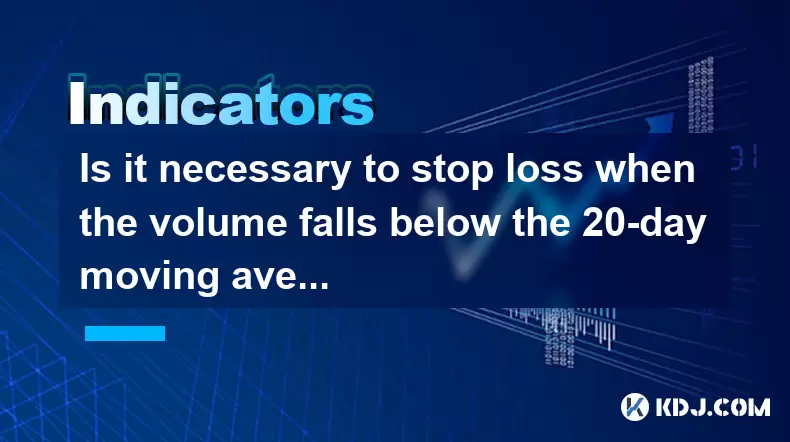
Is it necessary to stop loss when the volume falls below the 20-day moving average?
Jun 25,2025 at 05:00pm
Understanding the 20-Day Moving Average in Cryptocurrency TradingIn cryptocurrency trading, technical analysis plays a pivotal role in decision-making. One of the most commonly used indicators is the 20-day moving average (MA). This metric calculates the average price of an asset over the past 20 days and helps traders identify trends and potential reve...
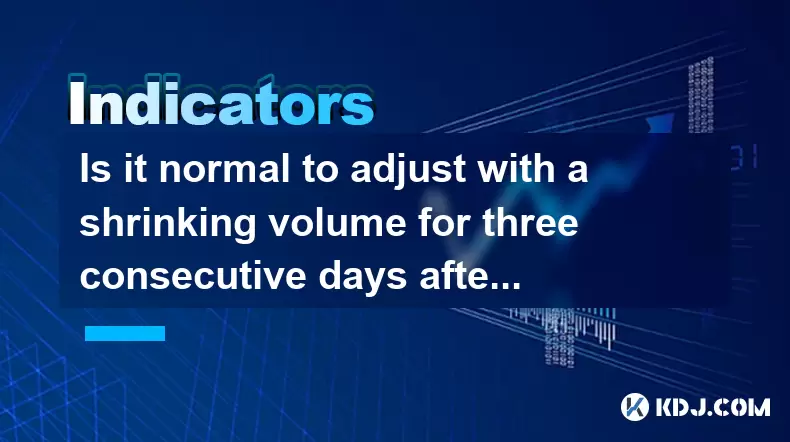
Is it normal to adjust with a shrinking volume for three consecutive days after breaking through the previous high with a large volume?
Jun 25,2025 at 03:49pm
Understanding Volume and Price Relationship in Cryptocurrency TradingIn cryptocurrency markets, volume is a critical metric that reflects the number of assets traded over a specific period. When a cryptocurrency breaks through a previous high with large volume, it typically signals strong buying pressure and market confidence. However, it's not uncommon...
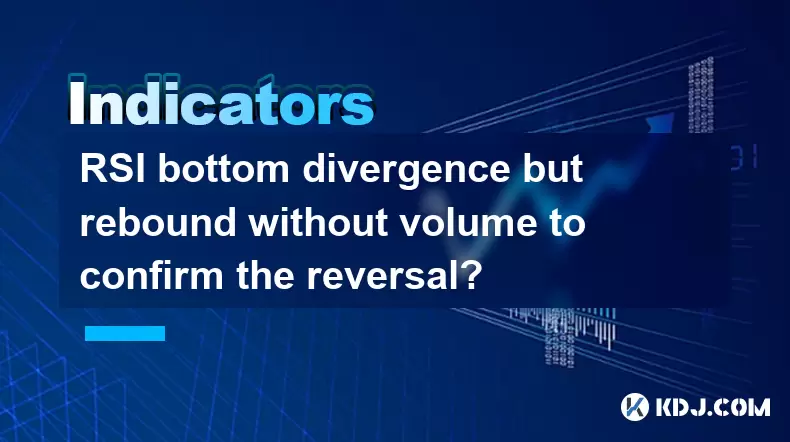
RSI bottom divergence but rebound without volume to confirm the reversal?
Jun 25,2025 at 04:42pm
Understanding RSI Bottom DivergenceRelative Strength Index (RSI) is a momentum oscillator used in technical analysis to measure the speed and change of price movements. RSI bottom divergence occurs when the price of an asset makes a new low, but the RSI does not confirm that low and instead forms a higher low. This pattern suggests weakening downward mo...
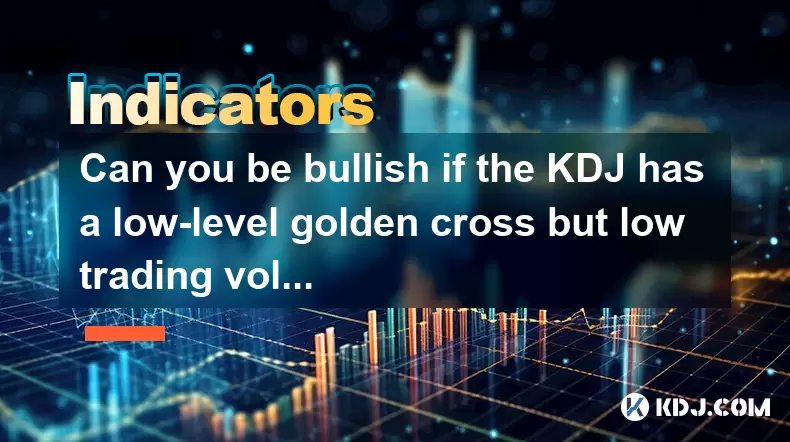
Can you be bullish if the KDJ has a low-level golden cross but low trading volume?
Jun 25,2025 at 03:14pm
Understanding the KDJ Indicator in Cryptocurrency TradingThe KDJ indicator, also known as the stochastic oscillator, is a momentum-based technical analysis tool widely used in cryptocurrency trading. It comprises three lines: the %K line (fast stochastic), the %D line (slow stochastic), and the J line (divergence value). These lines oscillate between 0 ...
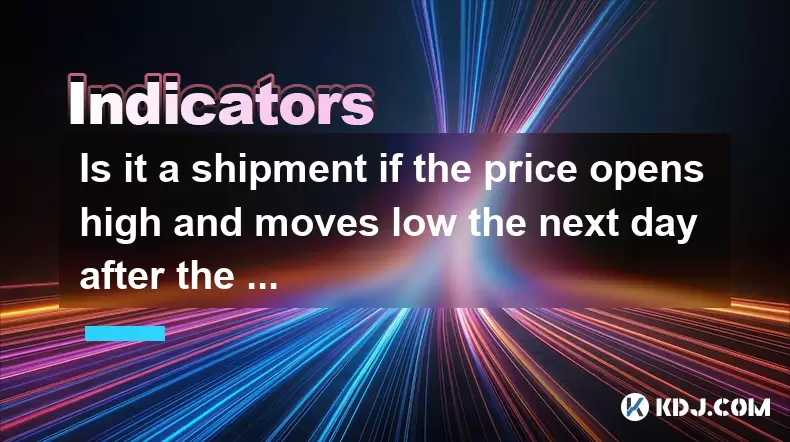
Is it a shipment if the price opens high and moves low the next day after the daily limit with huge volume?
Jun 25,2025 at 12:56pm
Understanding the Concept of a Shipment in Cryptocurrency TradingIn cryptocurrency trading, the term shipment refers to a scenario where large volumes of an asset are sold off rapidly, often leading to a significant price drop. This is typically associated with whale activity or coordinated selling by major holders. When traders observe certain patterns...
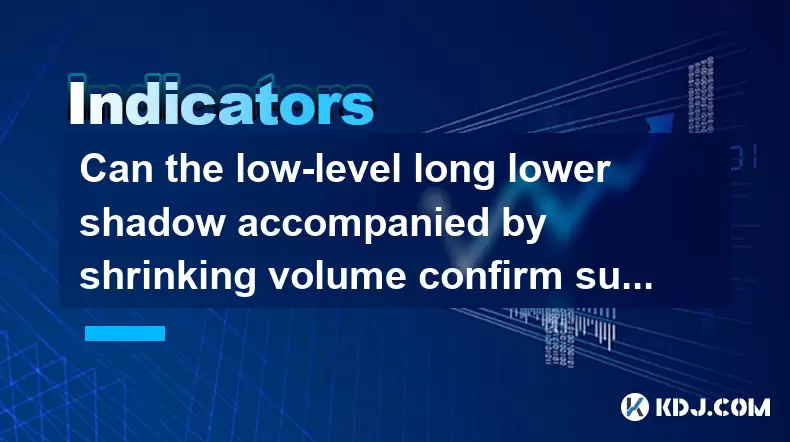
Can the low-level long lower shadow accompanied by shrinking volume confirm support?
Jun 25,2025 at 03:08pm
Understanding the Long Lower Shadow Candlestick PatternA long lower shadow candlestick pattern occurs when a candle closes near its high but has a significantly long lower wick, indicating that sellers pushed prices down during the session but were met with strong buying pressure that drove the price back up. This pattern is often seen as a potential si...

Is it necessary to stop loss when the volume falls below the 20-day moving average?
Jun 25,2025 at 05:00pm
Understanding the 20-Day Moving Average in Cryptocurrency TradingIn cryptocurrency trading, technical analysis plays a pivotal role in decision-making. One of the most commonly used indicators is the 20-day moving average (MA). This metric calculates the average price of an asset over the past 20 days and helps traders identify trends and potential reve...

Is it normal to adjust with a shrinking volume for three consecutive days after breaking through the previous high with a large volume?
Jun 25,2025 at 03:49pm
Understanding Volume and Price Relationship in Cryptocurrency TradingIn cryptocurrency markets, volume is a critical metric that reflects the number of assets traded over a specific period. When a cryptocurrency breaks through a previous high with large volume, it typically signals strong buying pressure and market confidence. However, it's not uncommon...

RSI bottom divergence but rebound without volume to confirm the reversal?
Jun 25,2025 at 04:42pm
Understanding RSI Bottom DivergenceRelative Strength Index (RSI) is a momentum oscillator used in technical analysis to measure the speed and change of price movements. RSI bottom divergence occurs when the price of an asset makes a new low, but the RSI does not confirm that low and instead forms a higher low. This pattern suggests weakening downward mo...

Can you be bullish if the KDJ has a low-level golden cross but low trading volume?
Jun 25,2025 at 03:14pm
Understanding the KDJ Indicator in Cryptocurrency TradingThe KDJ indicator, also known as the stochastic oscillator, is a momentum-based technical analysis tool widely used in cryptocurrency trading. It comprises three lines: the %K line (fast stochastic), the %D line (slow stochastic), and the J line (divergence value). These lines oscillate between 0 ...

Is it a shipment if the price opens high and moves low the next day after the daily limit with huge volume?
Jun 25,2025 at 12:56pm
Understanding the Concept of a Shipment in Cryptocurrency TradingIn cryptocurrency trading, the term shipment refers to a scenario where large volumes of an asset are sold off rapidly, often leading to a significant price drop. This is typically associated with whale activity or coordinated selling by major holders. When traders observe certain patterns...

Can the low-level long lower shadow accompanied by shrinking volume confirm support?
Jun 25,2025 at 03:08pm
Understanding the Long Lower Shadow Candlestick PatternA long lower shadow candlestick pattern occurs when a candle closes near its high but has a significantly long lower wick, indicating that sellers pushed prices down during the session but were met with strong buying pressure that drove the price back up. This pattern is often seen as a potential si...
See all articles























































































